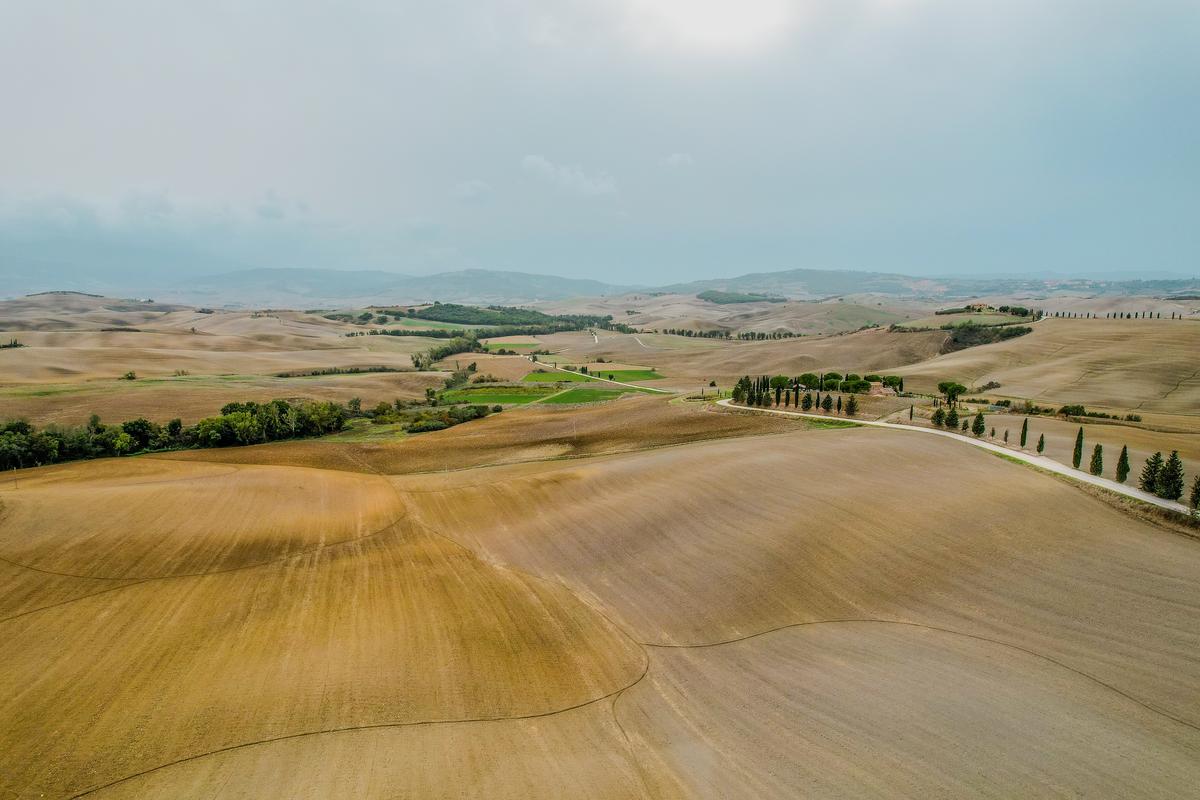Tuscany Travel Guide: Things to Do & Travel Tips for 2024
7 min readDestination Details
Province: Tuscany
Country: Italy
Region/Continent: Europe
Additional Info
: 3,651,152
: Central European Standard Time
: Italian
: Euro
About
Tuscany, Italy’s heartland of history and scenery, is where the past and present merge in a tapestry of art, architecture, and landscapes. It is a land where Etruscan heritage and Roman footprints mingle with the Renaissance’s flourish.
This can be witnessed in cities such as Florence, Siena, and Pisa, as well as in lesser-known yet equally charming towns like Lucca, Cortona, San Gimignano, Volterra, Montalcino, Pienza, and Montepulciano.
The Tuscan countryside boasts iconic hilltop towns and picturesque cities that have inspired artists for centuries.
The rolling hills, dotted with vineyards and olive groves, frame rustic farms and dramatic cypress-lined driveways. The province of Livorno offers maritime allure, while the island of Elba provides coastal respite with its beaches.
Tuscany’s rich cultural heritage is encapsulated by the serenity of the Arno River, which flows through the region’s capital, Florence. Here, you’ll find the esteemed Uffizi Gallery, the famed Duomo, and the historic Ponte Vecchio.
In Siena, the Piazza del Campo and its historic center beckon, while Pisa is renowned for its Field of Miracles and iconic Leaning Tower.
Many also explore the region’s Romanesque architecture, immerse themselves in films like “Under the Tuscan Sun,” and enjoy day trips to neighboring regions such as Umbria. Others venture further afield to cities like Bologna, Milan, Rome, and Venice.
Visitors find solace in the hill towns, each telling its story amidst settings that seem suspended in time.
Best Time to Visit
Spring (April – May):
For those planning a trip to Tuscany, spring offers a delightful setting with its mild weather and sparse crowds. A traveler will find accommodations easier to book, and the region’s natural beauty is at its peak with blooming flowers and green landscapes.
- April: Expect a lively atmosphere with Easter celebrations.
- May: Ideal for countryside explorations and city tours.
Summer (June – August):
Summer attracts tourists with its warm, sunny days, though it can get quite hot. Coastal destinations are crowded but provide excellent beach vacation options.
- June: Cultural festivals celebrate the feast of St. John the Baptist in Florence.
- July – August: High temperatures; ideal for sun-seekers and beach-goers.
Fall (September – October):
Autumn paints Tuscany in warm hues and also hosts wine harvests. It’s a perfect time for sampling local delicacies and wines.
- September: Still warm, beginning to cool down.
- October: Cooler temperatures and fewer tourists.
Winter (November – February):
Winter is off-season, providing a more intimate and cost-effective travel experience. One should consider staying in the heart of cities like Florence, where historic charm and fewer tourists make for an authentic experience.
- December: Holiday markets and festivities.
- January – February: Cold with possible snow, suitable for those who appreciate peaceful ambiances.
| Month | Benefit |
|---|---|
| Apr – May | Pleasant weather, less crowded |
| Jun – Aug | Vibrant, suited for beach holidays |
| Sep – Oct | Harvest season, scenic beauty |
| Nov – Feb | Cooler, budget-friendly travel |
Remember, Tuscany’s landscapes and culture can be enjoyed year-round, and each season holds its unique charm. Whether gazing at the rolling hills in spring or cozying up in a hilltop village in winter, planning your travel dates around these times enhances the Tuscan experience.
Cultural and Social Information
Cultural Heritage
Tuscany, a region steeped in art and history, is a cultural treasure trove of Italy. The UNESCO World Heritage list includes several sites here, not only the historic centers of Florence and Siena but also San Gimignano, known for its towers, and Pienza, a quintessential Renaissance town.
- Florence boasts the Uffizi Gallery, housing masterpieces by Leonardo da Vinci and Botticelli.
- Siena enchants with its medieval cityscape and the famous Piazza del Campo.
- Pisa is renowned for its Leaning Tower, an architectural marvel that defies gravity.
- Montecatini Terme impresses with its historic spas and unique Liberty-style architecture.
The Val d’Orcia region offers an incredible landscape that encapsulates the essence of Tuscany’s rural charm. Here, one can witness the harmonious blend of nature and human creativity that has persisted since the Renaissance. This area epitomizes the romantic and rustic allure of Tuscany, with its rolling hills and well-preserved medieval towns.
For visitors, Tuscany’s cultural experiences extend beyond the visual. Engaging in local festivals and sampling traditional Tuscan cuisine connect them to the region’s heritage. As they walk the cobbled streets of hilltop towns, they tread paths that countless others have over centuries, creating a link to the past that is felt as much as it is seen.
Local Customs and Etiquette
When traveling through Tuscany, one should respect local customs and social norms. They should be mindful of how their behavior affects those around them. Understanding these unwritten rules will greatly enhance their experience and interactions with locals.
- Greetings: A handshake is common when meeting someone for the first time. However, if they are introduced to a local by a mutual friend, expect a cheek kiss—it’s a sign of warmth.
- Dress Code: Visitors should dress modestly, especially when visiting religious sites like cathedrals. Shoulders and knees ought to be covered.
- Dining Etiquette: When they’re at a restaurant, they should wait to be seated. Before eating, it’s polite to say “Buon appetito” to their companions. Tipping isn’t mandatory but appreciated for good service (around 5-10% is sufficient).
- Punctuality: Italians value punctuality for business engagements but are more relaxed socially. It’s acceptable to arrive up to 15 minutes late when invited to someone’s home.
When in markets or shops, haggling isn’t a part of the culture as it is in other countries. Prices are to be respected as marked, and it is considered impolite to suggest otherwise. Additionally, visitors should remember that siesta time is observed, and many businesses may close in the afternoon for a few hours.
Travel Logistics
How to Get Around
When traversing the rich landscapes of Tuscany, visitors have several transportation options. Car rentals offer the most flexibility, allowing access to secluded areas and the charming small towns dotting the region.
The roads provide scenic views, which is a draw for those who choose to drive. For those who prefer public transportation, the train network efficiently connects major cities like Florence, Siena, and Pisa. The ‘treno regionale’ services smaller towns, while Intercity trains are faster and primarily connect larger hubs.
Buses complement the train service, reaching areas inaccessible by rail. They are especially useful for visiting hilltop towns, as buses often deposit visitors in the heart of these picturesque destinations.
Many travelers enjoy exploring Tuscany by bike, which is eco-friendly and offers an immersive experience of the Tuscan countryside.
Bike rental shops are available in most towns, and the rolling landscapes, while challenging, reward cyclists with stunning views.
| Transportation Mode | Ideal For | Limitations |
|---|---|---|
| Car Rental | Flexibility & Remote Areas | Traffic & Parking Challenges in Bigger Cities |
| Train | Cost-effective & Quick City Links | Limited Service to Smaller Towns |
| Bus | Access to Rural Towns | Less Frequent Schedules |
| Bike | Scenic Routes & Short Distances | Physically Demanding, Weather Dependent |
How to Get There
Tuscany is accessible internationally via two main airports: Florence (Aeroporto di Firenze-Peretola) and Pisa (Pisa International Airport). Pisa is a hub for low-cost airlines, often providing economical options for travelers.
Once landed, visitors can reach the city centers through various modes of transportation.
From Pisa International Airport:
- Bus: A bus ride to Pisa city center takes approximately 12 minutes and costs around €1.10.
- Train: Visitors can take a train to Florence, which takes about 1-1.5 hours, with tickets priced at roughly €9.
From Florence Airport:
- Taxi or shuttle: Convenient but typically more costly than public transport.
Direct flights from major cities like Atlanta and Boston are available for those flying into Rome. From Rome, travelers can continue their journey to Tuscany by train or rental car.
Train Travel:
Traveling within Tuscany by train is an efficient way to explore the region.
Key destinations like Siena, Lucca, and Arezzo are well-connected to Florence, which acts as a central railway hub.
By Car:
Renting a car might be ideal for an intimate exploration of Tuscany.
It provides the flexibility to follow one’s own itinerary and pace, discover off-the-beaten-path towns, and enjoy the scenic landscapes.
Distances to Key Tuscan Cities from Florence:
- Pisa: ~1 hour
- Siena: ~1.5 hours
- Lucca: ~1 hour
Travelers should consider acquiring a detailed map or a GPS-enabled device for navigation, especially when exploring rural areas.
Public transportation may be limited outside major tourist hubs, making a car rental a valuable choice for a comprehensive travel experience.
Neighborhoods
Tuscany is a region that boasts a wealth of art, history, and natural beauty. One cannot miss Florence, the cradle of the Renaissance, with its Uffizi Gallery housing masterpieces by Michelangelo, Leonardo da Vinci, and other greats.
The Historic Center of Florence also features the impressive dome engineered by Brunelleschi and the famed marble sculptures by Donatello.
Beyond art, the Chianti wine region invites visitors to savor the flavors of its renowned Chianti Classico wines amidst rolling hills. For a more intimate wine experience, visit the less crowded Vernaccia vineyards near San Gimignano.
Moving towards the bucolic serenity of the Val d’Orcia, the scenery transforms into a quilt of golden fields, punctuated by cypress trees and historical farmhouses. It’s a region that effortlessly exemplifies rural Tuscany and is known for its exquisite truffles and olive oil.
On the coast, the Maremma area offers a more rustic Tuscan charm with wild landscapes and ancient ruins. Nearby, the Tuscan archipelago harbors beautiful islands and beaches perfect for a seaside escape.
| Region | Highlights |
|---|---|
| Florence | Uffizi Gallery, Brunelleschi’s Dome, Renaissance artworks |
| Chianti | Wine tastings, Scenic vineyards, Chianti Classico |
| Val d’Orcia | Rolling hills, Cypress trees, Truffles and olive oil |
| Maremma | Rustic countryside, Ancient ruins, Seaside towns |
| Tuscan Islands | Beaches, Natural reserves, Island hopping |
Each area presents its slice of Tuscany, offering a unique blend of art, taste, and natural splendor that awaits exploration.




